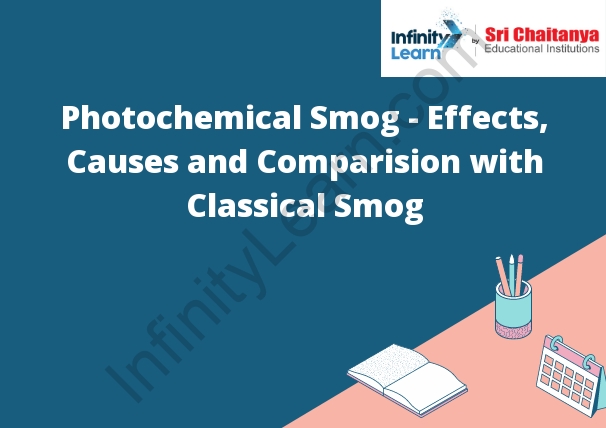Table of Contents
Smog
Photochemical Smog: Smog is a type of air pollution. It is a mixture of air pollutants, including sulfur dioxide, nitrogen dioxide, ozone, and particulate matter. Smog can cause a variety of health problems, including respiratory problems, heart problems, and even death.

Types of Smog
There are two types of smog:
1. Photochemical smog:
This type of smog is caused by the reaction of sunlight with certain chemicals in the atmosphere, such as nitrogen oxides and volatile organic compounds (VOCs). These reactions produce ozone and other pollutants, which can cause respiratory problems and other health issues.
2. Natural smog:
This type of smog is caused by the burning of organic matter, such as forests or peat bogs. It can produce large amounts of smoke, soot, and other pollutants, which can cause respiratory problems and other health issues.
Effects of Photochemical Smog
- Photochemical smog is a type of air pollution that is caused by the reaction of sunlight with chemicals in the atmosphere.
- These chemicals include nitrogen oxides and volatile organic compounds. When these chemicals react with sunlight, they form ozone and other pollutants.
- Photochemical smog can cause a number of health problems, including asthma, bronchitis, and heart disease. It can also cause eye irritation and damage to plants.
Causes of Smog
- Smog is a type of air pollution. It is a mixture of air pollutants, including ground-level ozone, particulate matter, and nitrogen dioxide.
- Smog is created when emissions from cars, power plants, and other sources react in the atmosphere.
- Smog is a type of air pollutant. The word “smog” is a combination of the words “smoke” and “fog”. Smog is made up of smoke and fog. Smog is a type of air pollutant. The word “smog” is a combination of the words “smoke” and “fog”. Smog is made up of smoke and fog.
- Smog is made up of many different types of air pollutants. The most common type of air pollutant in smog is particle pollution. Particle pollution is made up of tiny particles of pollution. These tiny particles can cause serious health problems.
- Smog can cause a number of health problems. It can cause asthma attacks, heart problems, and even death. Smog can also cause problems with breathing and lung problems.
- Smog is also a major cause of climate change. Smog can cause global warming and create a hole in the ozone layer.
- There are many different causes of smog. The most common cause of smog is the burning of fossil fuels. Fossil fuels are fuels that are made from the remains of plants and animals. Some of the most common types of fossil fuels are coal, oil, and natural gas.
- Smog is also caused by the burning of other materials. These materials include rubber, plastic, and other types of garbage.
- Smog is also caused by the emissions from cars and other vehicles. Cars and other vehicles emit a number of different types of air pollutants. These pollutants include carbon monoxide, nitrogen dioxide, and sulfur dioxide.
- There are many things that we can do to help reduce smog. We can reduce the number of cars that we use. We can also reduce the number of materials that we burn. We can also plant trees and other plants. These plants can help to reduce the amount of particle pollution in the air.
Difference Between Classical Smog And Photochemical Smog
- Classical smog is made up of particles and gases that come from the burning of coal and oil. Photochemical smog is made up of pollutants that react in the sun to create ozone and other harmful compounds.
- There are many types of smog, but two of the most common are classical smog and photochemical smog. Classical smog is mainly caused by the burning of coal and oil, while photochemical smog is mainly caused by the burning of gasoline.
- Classical smog is a type of smog that is mainly caused by the burning of coal and oil. It is made up of a mixture of sulfur dioxide, nitrogen oxides, and smoke. Sulfur dioxide and nitrogen oxides are two of the main causes of acid rain. Smoke contains many harmful chemicals, including carcinogens.
- Photochemical smog is a type of smog that is mainly caused by the burning of gasoline. It is made up of a mixture of volatile organic compounds and ozone. Volatile organic compounds are chemicals that vaporize easily. Ozone is a harmful gas that can cause respiratory problems.








